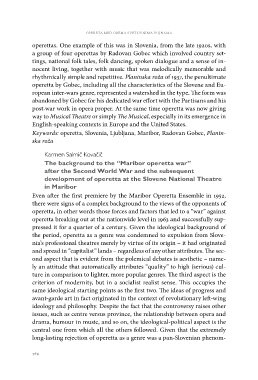Page 566 - Weiss, Jernej, ur./ed. 2021. Opereta med obema svetovnima vojnama ▪︎ Operetta between the Two World Wars. Koper/Ljubljana: Založba Univerze na Primorskem in Festival Ljubljana. Studia musicologica Labacensia, 5
P. 566
opereta med obema svetovnima vojnama
operettas. One example of this was in Slovenia, from the late 1920s, with
a group of four operettas by Radovan Gobec which involved country set-
tings, national folk tales, folk dancing, spoken dialogue and a sense of in-
nocent living, together with music that was melodically memorable and
rhythmically simple and repetitive. Planinska roža of 1937, the penultimate
operetta by Gobec, including all the characteristics of the Slovene and Eu-
ropean inter-wars genre, represented a watershed in the type. The form was
abandoned by Gobec for his dedicated war effort with the Partisans and his
post-war work in opera proper. At the same time operetta was now giving
way to Musical Theatre or simply The Musical, especially in its emergence in
English-speaking contexts in Europe and the United States.
Keywords: operetta, Slovenia, Ljubljana, Maribor, Radovan Gobec, Planin
ska roža
Karmen Salmič Kovačič
The background to the “Maribor operetta war”
after the Second World War and the subsequent
development of operetta at the Slovene National Theatre
in Maribor
Even after the first premiere by the Maribor Operetta Ensemble in 1952,
there were signs of a complex background to the views of the opponents of
operetta, in other words those forces and factors that led to a “war” against
operetta breaking out at the nationwide level in 1963 and successfully sup-
pressed it for a quarter of a century. Given the ideological background of
the period, operetta as a genre was condemned to expulsion from Slove-
nia’s professional theatres merely by virtue of its origin – it had originated
and spread in “capitalist” lands – regardless of any other attributes. The sec-
ond aspect that is evident from the polemical debates is aesthetic – name-
ly an attitude that automatically attributes “quality” to high (serious) cul-
ture in comparison to lighter, more popular genres. The third aspect is the
criterion of modernity, but in a socialist realist sense. This occupies the
same ideological starting points as the first two. The ideas of progress and
avant-garde art in fact originated in the context of revolutionary left-wing
ideology and philosophy. Despite the fact that the controversy raises other
issues, such as centre versus province, the relationship between opera and
drama, humour in music, and so on, the ideological-political aspect is the
central one from which all the others followed. Given that the extremely
long-lasting rejection of operetta as a genre was a pan-Slovenian phenom-
564
operettas. One example of this was in Slovenia, from the late 1920s, with
a group of four operettas by Radovan Gobec which involved country set-
tings, national folk tales, folk dancing, spoken dialogue and a sense of in-
nocent living, together with music that was melodically memorable and
rhythmically simple and repetitive. Planinska roža of 1937, the penultimate
operetta by Gobec, including all the characteristics of the Slovene and Eu-
ropean inter-wars genre, represented a watershed in the type. The form was
abandoned by Gobec for his dedicated war effort with the Partisans and his
post-war work in opera proper. At the same time operetta was now giving
way to Musical Theatre or simply The Musical, especially in its emergence in
English-speaking contexts in Europe and the United States.
Keywords: operetta, Slovenia, Ljubljana, Maribor, Radovan Gobec, Planin
ska roža
Karmen Salmič Kovačič
The background to the “Maribor operetta war”
after the Second World War and the subsequent
development of operetta at the Slovene National Theatre
in Maribor
Even after the first premiere by the Maribor Operetta Ensemble in 1952,
there were signs of a complex background to the views of the opponents of
operetta, in other words those forces and factors that led to a “war” against
operetta breaking out at the nationwide level in 1963 and successfully sup-
pressed it for a quarter of a century. Given the ideological background of
the period, operetta as a genre was condemned to expulsion from Slove-
nia’s professional theatres merely by virtue of its origin – it had originated
and spread in “capitalist” lands – regardless of any other attributes. The sec-
ond aspect that is evident from the polemical debates is aesthetic – name-
ly an attitude that automatically attributes “quality” to high (serious) cul-
ture in comparison to lighter, more popular genres. The third aspect is the
criterion of modernity, but in a socialist realist sense. This occupies the
same ideological starting points as the first two. The ideas of progress and
avant-garde art in fact originated in the context of revolutionary left-wing
ideology and philosophy. Despite the fact that the controversy raises other
issues, such as centre versus province, the relationship between opera and
drama, humour in music, and so on, the ideological-political aspect is the
central one from which all the others followed. Given that the extremely
long-lasting rejection of operetta as a genre was a pan-Slovenian phenom-
564


